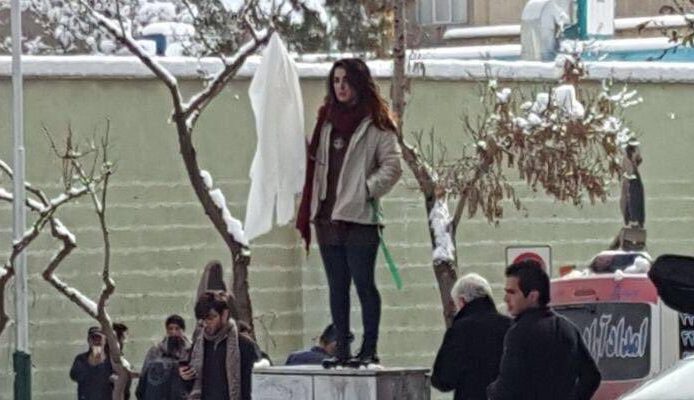by Aida Ghajar
The trial of Narges Hosseini, one of Iran’s “Revolution Women,” began on the morning of Saturday, February 24. Hosseini has been charged with “encouraging immorality or prostitution,” “failing to observe hijab” and “flagrant commitment of a forbidden act.” At her hearing, her lawyer Nasrin Sotoudeh and her colleagues presented their bill of defense.
Narges Hosseini was the second woman to have been given the nickname “Revolution Woman,” part of the resistance movement in which women tie their headscarf to a stick and wave it in public to protest against forced hijab. The movement has also been dubbed the “Women of Revolution Street,” or “Revolution Girls.”
Sotoudeh says that other women who have joined the protest across several cities are currently being held at Vozara Detention Center in Tehran. She also says that some of them have been physically assaulted while in detention.
Of the charges against Hosseini, the most serious one is “encouraging immorality or prostitution.” If she is acquitted of this charge, the two other lesser charges will be dropped. On February 24, the police announced that encouraging women to remove their hijabs falls under Proviso B of Article 639 of the Islamic Penal Code, which declares: “Anyone [who] facilitates or encourages people to immorality or prostitution” must be sentenced to between one to 10 years in prison. The punishment is equal to that stipulated in Proviso A of the code, which refers to anyone “who establishes or directs a place of immorality or prostitution.” According to the statement issued by the police, this is a “flagrant crime,” and if the police fail to take action against such a crime then the police force itself will be guilty of breaking the law and will be liable to prosecution.
The police statement also refers to Article 638, which stipulates: “Women who appear in public places and roads without wearing an Islamic hijab shall be sentenced to [between] 10 days to two months’ imprisonment or a fine.” But neither the police nor responsible officials have commented on the accusation that the arrested women have been beaten in custody or during arrest.
Police Brutality in Public
The latest woman to join the protest is Maryam Shariatmadari, a 32-year-old computer science student at Tehran’s Amir Kabir University of Technology. She stood on top of a utility box on February 22 and waved her headscarf. A group of people gathered around her and took photographs and recorded videos. Then two policemen arrived. One of them climbed up on the box and brutally kicked Shariatmadari down to the ground. The moment was captured on video and posted on YouTube. According to Nasrin Sotoudeh, Shariatmadari sustained a fractured knee as a result of the fall.
“When the policeman pushed her down in that violent way, it shocked the surrounding crowd,” one eyewitness told the Center for Human Rights in Iran (CHRI). “The girl was on the ground for a few minutes and she struggled to get up, limping. The crowd quickly surrounded her and didn’t let the police come close. We got her a taxi and she left, but the policemen followed her. I heard the taxi was stopped at the next crossing and they arrested her.”
Other reports claim that the police refused to take her to the hospital to treat her injury and that she was beaten at the detention center as well.
According to CHRI, the authorities in Tehran have tried to prevent people from joining the movement by deploying additional policemen to patrol busy streets, and by installing slanted metal sheets on top of utility boxes to make it difficult for people to stand on them. Just before Maryam Shariatmadari was arrested, someone posted photographs of policemen installing covers on boxes on social media, inviting much ridicule. Later, when the video of a policeman kicking Shariatmadari off the utility box was posted online, she became yet another symbol of the fight against forced hijab.
Interior Ministry Speaks out Against Violence
Many people on social media condemned the police’s use of violence. Even Iran’s Interior Ministry chided the police for using force against Shariatmadari. “Dealing with infractions should be with full respect of moral and legal rules,” the Interior Ministry spokesman Salman Samani said on Sunday, February 25. “No one has a license to act against the law even in the role of an officer dealing with crimes.”
As of now, we know the names of five “Revolution Women” who have been arrested: Vida Movahed, the first woman to stand on a utility box on Revolution (“Enghelab”) Street in Tehran, waving her white headscarf, Narges Hosseini, Azam Jangroy, Shaparak Shajarizadeh, and Maryam Shariatmadari. Vida Movahed and Narges Hosseini have been freed on bail but the rest remain incarcerated. Nasrin Sotoudeh, who represents some of the detainees, told IranWire that all the women who are being held at Vozara Detention Center have said they have been beaten.
The case of Shaparak Shajarizadeh, however, is somewhat different. Her case could signal the beginning of the Revolution Women protesters being handled as “security cases.” According to Sotoudeh, Shajarizadeh’s case has been sent to the Security Court at Evin Prison. Before her protest, Shajarizadeh had consulted Sotoudeh and appointed her to be her lawyer, knowing that she would be arrested and charged. Sotoudeh has yet to be allowed to talk to her client but, according to Shajarizadeh’s husband, she has been beaten and has been injected with a drug against her will.
Violating both Iranian and International Laws
Sotoudeh says that under both Iranian and international laws and conventions that the Islamic Republic has joined, “insulting, humiliating and beating” detainees is illegal and considered to be major crimes. Detainees who have been subjected to such treatment have the legal right to complain. If their complaints are handled justly and with the due process of law, the people responsible for such offences can be dismissed from their jobs for “abusing their position as government and police agents,” or even be arrested in some cases.
As Human Rights Watch (HRW) points out, the “International Covenant on Civil and Political Rights (ICCPR), which Iran has ratified, guarantees people’s right to freedom of expression, to privacy, and to freedom of religion. Several United Nations independent experts have criticized rules that require wearing religious dress in public.”
But in the Islamic Republic, not only do authorities not pay any attention to the violent treatment of women under arrest, the police force is actually playing the role of both prosecutor and judge. “I have no idea why the police [force] thinks it is the examining magistrate and makes such pronouncements,” said Sotoudeh. “The police must wait for the judicial officials. Such statements by the commander of the police exceed his legal duties and power.”
But the placement of slanted roofs on utility boxes, violence against protesting women and unrelenting threats have yet to stop the current movement against forced hijab. New videos from Tehran and other towns showing women and even some men waving scarves keep appearing and being shared online.
Two studies by government agencies show that most Iranians believe that hijab is a personal choice and must be voluntary, not forced. But the authorities refuse to accept reality and instead resort to making bizarre comments and theories.
“High” Saboteurs
For example, Gholam Hossein Mohseni Ejei, the First Vice Chief Justice of Iran, has accused the protesting women of using “illegal substances” and being part of a plot against the Islamic Republic. In effect, these women are considered to be “substance-abusing saboteurs”. He said that “if it is proven that they are connected to certain organizations, serious cases will be opened against them and they and their families will get into trouble.” This comment from Ejei also inadvertently reveals that the Iranian judiciary harasses the families of the accused even if these family members have committed no illegal act.
On January 31, Tehran’s Prosecutor Abbas Jafari Dolatabadi said that women who have removed their headscarves in public to protest against mandatory hijab are acting childishly. He announced that they were acting out of ignorance and because they have been deceived by foreign influence. Ali Motahari, deputy speaker of the parliament, offered a shocking comment on the situation. He denied that hijab is actually “forced” in Iran. Many women, he said, “appear in public in whatever way they want, so there is no coercion.”
Regardless of these comments, social networks are now brimming with photographs, videos and drawings of the Revolution Women. Some have even fantasized that one day statues of these women will be installed in Tehran’s Azadi (“Freedom”) Square.
And now a new hashtag is making the rounds on Twitter. Tagging posts with “#If I Am There,” Iranians have been describing what they plan to do if they find themselves witness to a woman taking off her scarf and waving it in the air.
“I will not stand still if I come across an act of protest by ‘#Revolution Women,’” tweeted Shakiba. “Having a conversation among the watching crowd and with passers-by is very important. A conversation about the need for protest and for gains through solidarity. We must prevent the arrest of these women.”
A woman called Negar tweeted that if she was present during a protest, she would try to persuade everyone there to come together as a protective wall to prevent the protester being arrested.
Another person going by the name of Goli tweeted: “The oppressive regime is spending every second of its existence in terrorizing the society. Choosing what one must do, how to fight and how to react is not so simple. ‘#If I am There’ I will use the power of all historical and class memories to stand against oppression.”
Another person, Farzaneh, suggested that it would be a good idea to set up a “committee of mothers” whose children have been killed by the regime or who have been arrested. The committee could accompany Revolution Women to the location where they want to protest.
Like Rape
Another tweet by “the Agnostic” compares the treatment of Revolution Women to rape: “‘#If I Am There,’ as a man who has enjoyed the benefits of being a man in the Islamic patriarchal system, I believe that it is my duty to prevent the ‘rapists’ (various security agents of the regime) from touching or kidnapping the woman — whatever way I can. To sum, I will react the same way that I would react if I witnessed a rape. It depends on how brave I am.”
Speaking about the recent protests, Human Rights Watch’s Middle East director Sarah Leah Whitson said: “For decades Iranian authorities have imposed a compulsory dress code on women, violating their basic freedom to express themselves and restricting access to economic and social opportunities for anyone who refuses. Now when women are peacefully protesting a discriminatory dress code, authorities are adding to their misdeeds by arresting them.”
In May 2017, Human Rights Watch documented instances where women in Iran faced discrimination in the workplace as a result of how they dress.
“The women of our country are moving forward like a river,” wrote Nasrin Sotoudeh on her Facebook page. “Don’t throw them down, don’t put them in prison and don’t put them on trial. They have committed no crime. What they want is to decide what to wear themselves.”
But now, according to the police, 29 of these women are in detention. We do not know the names of most of them. What we do know is that at least some of them have been beaten, at least one has been injured and been denied treatment, one is being tried, and now there is speculation that the regime is planning to bring security charges against them.
Reprinted, with permission, from IranWire. Photo: Narges Hosseini (courtesy of Center for Human Rights in Iran).






I wonder what’s the benefit of Western media about the Iranian internal affair, basically you telling us right now woman must allowed to be a naked you should focus something very important than that and ????